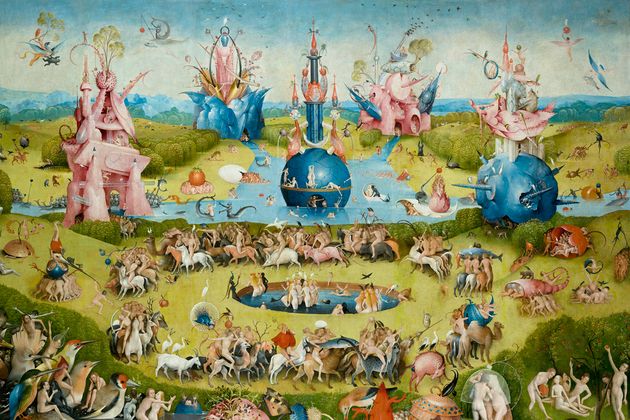His surviving works are rare and are in museums all over the world but, says Susan Mansfield, the Dutch artist remains a man of mystery
 The Garden of Earthly Delights in the Prado, in Madrid
The Garden of Earthly Delights in the Prado, in Madrid
FIVE hundred years ago, on 9 August 1516, the artist Hieronymus Bosch was buried in his home town of ’s-Hertogenbosch in the Netherlands. He left behind a body of work which still shimmers with originality, and contains some of the strangest images ever made in Western art.
The 500th anniversary of Bosch’s death brings celebrations of the artist across Europe. In s-Hertogenbosch, a year-long programme of events is underway. A major exhibition there at the Het Noordbrabants Museum this spring is followed by what claims to be the “most comprehensive ever” show of Bosch’s work at the Prado in Madrid this summer.
Remarkably little is known about Bosch. Even the year of his birth is approximate (c.1450). He came from a family of artists, lived all his life in s-Hertogenbosch, and is not known to have travelled. He worked for a series of wealthy and ecclesiastical patrons, making work primarily on religious themes. At some point in his career, Jeroen van Aken came to sign his paintings with the Greek version of his first name (Jherominus) and the abbreviated name for his home town. He was married, but died childless. His funeral (one of the few things in his life for which we have evidence) befitted a prosperous and respected man.
Of his thinking and artistic ambitions, we know even less. The paintings must speak for themselves: sensitive, moving portrayals of Christ and his Passion; imaginative depictions of heaven and hell that have not been equalled before or since; everyday life recorded with vivacity and realism; flights of fantasy which soar into a territory all their own. Bosch was an original: he did not belong to a movement, nor did he found one. He stands alone.
Some have concluded that his “splendid isolation” in s-Hertogenbosch, well away from the centres of artistic development, allowed him to develop his idiosyncratic vision. But his worldview is far from provincial: it is ambitious, confident, fully realised.
He lived through times of great change, of invention and discovery, plagues and wars, a post-medieval world in which learning and superstition co-existed and religious preachers conjured grosteques visions. He sits within a Northern Renaissance tradition, which placed biblical events in the realism of a contemporary world. But none of this quite explains him.
Bosch’s world was also on the cusp of religious change. One year after his death, Martin Luther pinned his 95 Theses to the door of All Saints Church in Wittenberg. Certainly, the satire of religious people in Bosch’s paintings - the singing nuns and drunken priests - was not new; the Church of the day was severely criticised for moral laxity and a purported preoccupation with wealth.
But Bosch’s vision went much further: the chimeras and monsters, torture machines and human-animal hybrids, the flying frogs and walking wine barrels, the wingless bird with leather boots on, the pig-faced man with the owl on his head … And because there is a sense that, in the words of Mario Bussagli, these were “used with a very definite purpose”, theories have abounded.
Bosch was a secret heretic; he had religious visitations; he took mind-altering drugs; he was a polymath, like Leonardo Da Vinci (with whom he was roughly contemporary) following and satirising the science of his day. Or perhaps he was simply a man in the grip of a vigorous imagination. One of the few sentences we have in Bosch’s own hand is inscribed on a page of sketches: “Poor is the mind that always uses the inventions of others and invents nothing itself.”
Bosch’s world had a Christian framework, it was created and ordered by God, but he seems to have been endlessly fascinated by the presence of evil: how it came to be there, what role it plays in the destiny of man. In that sense, he was a Christian moralist, depicting man as a weary pilgrim, struggling to choose well between good and bad. Some of his most important works are triptychs which show the world of mankind poised between depictions of Eden/heaven and judgement/hell.
These things had been depicted before, of course, but never in the way they were by Bosch. Never was heaven so celestial, so fresh and other-worldly; never did the earth teem with so much life, so much beauty and profanity, energy and strangeness; never was hell so cruel, so dark, so downright hellish. One might find echoes in Blake’s celestial geography, or Jake and Dinos Chapman’s fixation with hell, but none of them realised the vision as completely as Bosch.
His work has that quality all great art has of timelessness. His surviving works are rare and are in museums all over the world; this anniversary year represents a rare chance to see many of them grouped together. No doubt this will fuel further connections and discoveries, but it will not solve the mystery of Hieronymus Bosch. After 500 years, it is as strange and fascinating as ever it has been.
Bosch: The 5th Centenary Exhibition, will be at the Prado, from Madrid,31 May – 11 September, More information on the year-long programme of events in ’s-Hertogenbosch, here.
Susan Mansfield is a writer and journalist based in Scotland.
This article was first published in Solas magazine. Solas is published quarterly in the U.K. Click here to learn more or subscribe.

Las opiniones vertidas por nuestros colaboradores se realizan a nivel personal, pudiendo coincidir o no con la postura de la dirección de Protestante Digital.
Si quieres comentar o